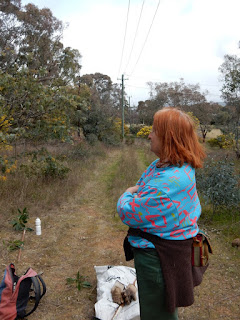MURRUNGUNDIE GUIDES’ VISIT
On Monday 13th November hours
after we’d continued our assault on the Tree of Heaven with Anne, Ted and Diana,
Angharad and I hosted a group of about twenty Murrungundie Guides for a stroll
on Mt Rogers. They normally meet at Charnwood near the Mt Rogers Scouts’ Hall
but wanted to renew acquaintance with the place.
In August 2010 some of their predecessors
planted shrubs 50m in from the Wickens Place carpark. This sprummer the shrubs
flowered again.
Four leaders, including Rhonda who’s been an
inspiring, local Guide Leader for over 30 years, took over from the girls’
parents at 18.00 hrs. We strolled along the Tween Tanks track where
Angharad introduced them to the Frogmouths. Father was on the nest with a
just-visible chick. Mother, in typical Frogmouth pose, was on a nearby branch.
We pointed out the differences in the trees’
ages by their sizes noting that the others had been planted as the four suburbs
were built around Mt Rogers 45–50 years ago. The view across CSIRO land and Hall
to Spring Range offered the chance to mention the opportunities of the
Centennial Trail’s walks. As we came within 200 m of the summit the impact
of Gungahlin & Crace was clear and treeless.
Once at the summit the girls began working
out the compass points and where their homes were. Rhonda asked them what they
thought the Trig Point was for. As we walked we found ourselves being asked
questions about the plants, the birds we saw and heard (the Bronzewing pigeons
were calling) and the likelihood of snakes and lizards. There were always
excited interactions between the girls. Currawongs’ calls increased as pre-dusk
approached.
The Guides divided into patrol groups to work
out the next few weeks’ programs whilst drinking water and eating their snacks.
They were able to complete missions in their Nature Play CBR Passports having
seen birds, a few flowers, the different trees and shrubs, bugs, beetles and
the distant views.
We pointed out the wild oats, relating them
to porridge and saying the plants were normally taller but the rain pattern had
kept the stalks shorter. On the return journey we paused at the Bench Mark Tree
for further drinks and a few photos.
As we neared Wickens Place again, one adult
heard “And we can see the sunset!”. If only more learning and fun could be
scheduled outdoors!
OUTDOORS CLASSROOMS
Summer obviously has its drawbacks for being
outdoors but once the restrictions of school hours have passed perhaps we can
all adopt the concept of getting up with the sun. Outdoor activities could then
be achieved in the cool of the day. Nature
PlayCBR Passports can be obtained via the Nature Play website, http://www.natureplaycbr.org.au/.
The passports suggest Missions for the children to find species and objects
outdoors. There are also several Playlists of Things to do before you’re…should anyone need activity ideas.
One idea I had but have never tried is to
take children on a bus ride from stops in Fraser, Spence, Charnwood, Melba to
southern ACT. With a notebook or clipboard in hand they can check off
observations of hills, clouds, weather, trees, animals, birds and inanimate
objects seen as they’re driven along. Fares costs apply & changes may be
needed unless travel happens before 10.15 am. There’s the advantage of
air-conditioned comfort.
PLAY AND PLAYGROUNDS
If you find yourself with “Google-time” in the
holidays, search for Forest Kindergarten. You’ll see refreshingly natural
approaches to learning that allow urban
students to follow their curiosity, to learn through applying their imagination
and to co-operatively develop their physique using structures from nature. Some
playgrounds around Canberra are becoming more natural to allow for unstructured
play. There’s
http://www.environment.act.gov.au/__data/assets/pdf_file/0010/906472/Explore-Canberra-Parks-and-Recreation-Guide.pdf
... which lists playgrounds and reserves in each ACT area.
WATER
Please ensure that birds visiting your garden have a
clean dish of water for drinking or bathing. We have a terracotta plant pot
saucer that also has a flat stone in it so small birds can reach the water. A
new response to feeding birds has emerged:https://www.theguardian.com/environment/2017/dec/09/feed-the-birds-stop-the-demonising-and-tell-us-how-to-do-it-properly
With the warmer weather water is more important than feeding the birds we share our places with. We’ve come to know Brown Thornbills in our shrubby garden. They come through seeking insects ans other invertebrates several times a day. Pest control without toxic chemicals!
With the warmer weather water is more important than feeding the birds we share our places with. We’ve come to know Brown Thornbills in our shrubby garden. They come through seeking insects ans other invertebrates several times a day. Pest control without toxic chemicals!
BLACKBERRIES
Ginninderra Catchment Group was awarded a grant for
Blackberry spraying on land that’s drained by Ginninderra Creek. Contractors
have reached the Mt Rogers infestations we recorded.
OTHER NOTES
I suspect the approximately 100 ml of rain we
received will be welcomed by weeds species. Until the soil dries out again it’s
quite ‘easy’ to dig out species like Flatweed. These are the yellow
Dandelion-like blooms on nature strips that await mowing. Each bloom can have
about 50 separate flowers and consequently the same number of readily blown
away seeds. If you have these flowers try to use a catcher when mowing, put the
mowings in a black plastic bag for several weeks to ‘cook’. Then, stealthily,
put the bag-full in the garbage bin. We’ve found in the past that chopped-off
Flatweed heads continue to develop seeds if just lying on the ground.
Our next working-bee will be on Sunday 28th
January but I’m sure our dedicated Mt Rogers landcarers will keep the
observations coming in.
Has anyone seen Superb Parrots this ‘season’? I have
a theory the Rainbow Lorikeets are deterring them from feeding on local Loquat
trees.
Phil’s responded to the rain by checking the erosion
channels regularly.
ENJOY the HOLIDAY
SEASON!
Rosemary (6259
4724)





























